Basic information about the temple
| Moolavar: | Jambukaranyeswarar | Ambal / Thayar: | Anandavalli |
| Deity: | Siva | Historical name: | |
| Vriksham: | Vilvam | Teertham: | Kumara Teertham |
| Agamam: | Age (years): | Timing: | 8 to 10 & 6 to 8 | Parikaram: |
| Temple group: | Vaippu sthalam | – | |
| Sung by: | Temple set: | ||
| Navagraham: | Nakshatram: | ||
| City / town: | Koonthalur | District: | Thanjavur |
| Maps from (click): | Current location | Kumbakonam (19 km) | Tiruvarur (25 km) |
| Mayiladuthurai (27 km) | Nagapattinam (50 km) |
Location
Sthala puranam and temple information

This is a Tevaram Vaippu Sthalam that finds mention in one of Appar’s pathigams. Sambandar is also believed to have worshipped here. This temple is more famous as a Murugan sthalam, due to the importance attached to the Murugan shrine inside the temple (see below).
Koonthalur gets its name from a Ramayanam connection. When Ravana was taking Sita away to Lanka, one of the strands of her hair (koonthal in Tamil refers to flowing hair on the head) fell here, and hence the place came to be known as Koonthalur. (According to another version, they stopped here for Sita to have a bath, and a strand of her hair was left behind; and the place she bathed at is called Sita Teertham.) In the temple’s inscriptions, the place is referred to as Chola Mandalathu Kulothunga Chola Valanaadu Tirunaraiyur Patru Keezh Koonthalur, which is clearly from the Chola period, and refers to Kulothunga Chola (the third; we will come to that shortly).
One puranam says that this place used to be a forest of Jambu (jamun / naval pazham) trees, and so the name of the moolavar here is Jambukaranyeswarar. Another says that Siva in this forest area, was worshipped by a jackal (which is another meaning of Jambu in Sanskrit), and hence the name,

Sage Romaharshana’s body was extremely hirsute (which is why he went by that name; Roma = hair in Sanskrit). The legend of the sage was that at the completion of the term of every Brahma, one hair of the sage would fall off. The sage was blessed with the power of drawing out gold coins from his beard, which he used to feed the poor and needy. Brahma felt that the importance given to the sage was unnecessary, and so taking the form of a barber, he offered to shave the sage’s beard. The sage agreed, and in the process, thousands of gold coins fell out, which Brahma collected and went away. After this, the sage was unable to produce coins from his beard. Enraged by this, and feeling let down by Siva who he worshipped constantly, the sage went to Jambukaranyam (this place) to question the Lord. Siva first sent his sons Vinayakar and Murugan to pacify the sage, and Murugan also created a Teertham so that the sage could refresh himself. Pleased by their devotion, the sage relented, and later worshipped Siva, after which his powers of drawing gold coins was restored to him.
According to another version, when the sage attempted to enter the temple, Vinayakar and Murugan refused to let him enter, since he was considered “impure”, having just shaved off his beard and not had a bath. However, Siva intervened and let the sage in, because the sage was completely pure in heart and mind, and physical “impurity” did not matter.
There is a separate shrine for the sage in the temple. Devotees offer oil to the sage’s murti, and applying this oil on oneself afterwards, is said to cure skin ailments.
Koonthalur Murugan is famous in His own right, since He is enshrined at a level higher than Siva, and has Saneeswaran installed facing Him. This arrangement is extremely rare, since Murugan is the adipathi of Sevvaai (Mars) and Saneeswaran is Sani (Saturn) personified. Therefore, worshipping here is said to rid devotees of all sorts of Sevvaai and Sani Dosham, which are the two principal types of doshams in astrology. Murugan has his hair tied upwards, resembling a crown (jata-makutam), which murti also appears to be from the Pallava period. In addition to His other ornaments like the weapon and rudraksham, Murugan sports makara (fish) shaped earrings. In His hands, he holds a rudraksha mala and palm leaf manuscripts, indicating his “Guru” status, imparting wisdom. In his Tiruppugazh, Arunagirinathar has extolled Murugan here as Kumaraguruparan. Saneeswaran here is called Shatru Samhara Sani.

The original temple is estimated to be over 1600 years old. In addition to the moolavar Lingam, there is a separate 16-faced Lingam near the Balasubramaniar shrine in the prakaram (not the main Murugan shrine of the temple), which suggests that it may be from the Pallava times, as that was one of their signature iconographic styles. Later, there were additions and renovations by the Cholas, of which there are some signs and vestiges. However, much of the present day structural temple is from the time of the Vijayanagara Dynasty, as further evidenced by an inscription referring to grants given to the temple during the time of Veerapratapa Krishna Deva Maharaya, dated to the early 16th century.
There are two Amman murtis at this temple – one to the right in the ardha-mandapam, and another in a separate shrine. There are shrines for the parivara devatas around the moolasthanam. In the temple complex is also an idol of Kulothunga Chola III, which is in damaged condition – rather sad, considering his contributions to the temple.
Other information for your visit
Although the place is easy to find, if one has to ask for directions, asking for the Koonthalur Murugan temple will yield better results!
Contact
Phone: 94435 24737; 96886 77538
The temple trustee and caretaker live nearby, and are more than happy to welcome visitors and open the temple upon request.
Gallery





















